| Author |
Message |
Stephen A. Fisher

Location: Kentucky USA Joined: 17 Oct 2003
Posts: 455
|
 Posted: Mon 05 Apr, 2004 1:49 pm Post subject: Seeking information of makers mark (18th century blade) Posted: Mon 05 Apr, 2004 1:49 pm Post subject: Seeking information of makers mark (18th century blade) |
 |
|
Hi All,
I was wondering if anyone could help me out on this one. My guess would be that this blade is of Solingen manufacture. (but I don't like to "guess" on matters like this  ) )
______________________________________
bare smallsword blade- circa 18th century
blade length- 25 1/16"
blade width- 1 2/16"
tang length- 6 3/4"
(floral etching remains beneath the light overall pitting)
thanks,
Stephen
 Attachment: 82.22 KB Attachment: 82.22 KB
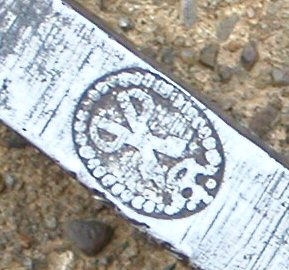
makers stamp on tang "tongue"
 Attachment: 106.97 KB Attachment: 106.97 KB

Last edited by Stephen A. Fisher on Mon 05 Apr, 2004 2:00 pm; edited 1 time in total
|
|
   |
 |
|
Steve Fabert
|
 Posted: Mon 05 Apr, 2004 1:53 pm Post subject: Posted: Mon 05 Apr, 2004 1:53 pm Post subject: |
 |
|
|
Is that a bayonet blade? I don't believe I have ever seen anything except a bayonet that had so pronounced a ridge on one side only.
|
|
  |
 |
Stephen A. Fisher

Location: Kentucky USA Joined: 17 Oct 2003
Posts: 455
|
 Posted: Mon 05 Apr, 2004 1:59 pm Post subject: Posted: Mon 05 Apr, 2004 1:59 pm Post subject: |
 |
|
...
 Attachment: 115.33 KB Attachment: 115.33 KB

 Attachment: 118.37 KB Attachment: 118.37 KB
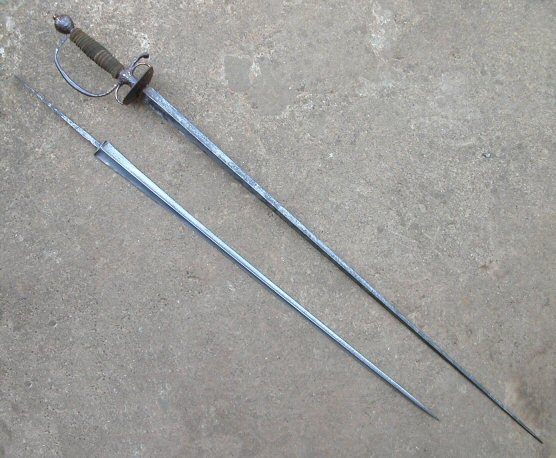
 Attachment: 57.3 KB Attachment: 57.3 KB

 Attachment: 103.99 KB Attachment: 103.99 KB
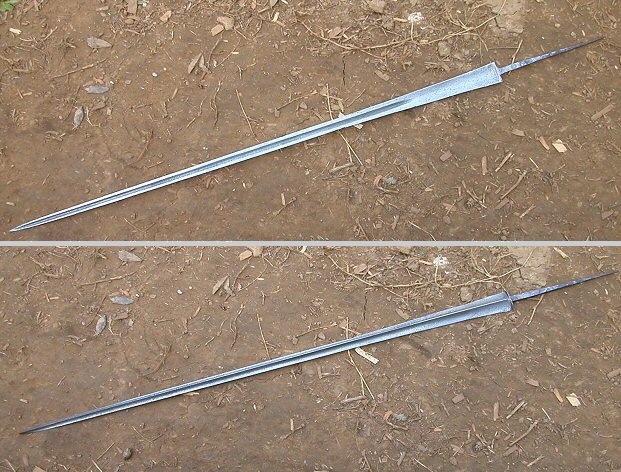
Last edited by Stephen A. Fisher on Mon 05 Apr, 2004 2:06 pm; edited 1 time in total
|
|
   |
 |
Stephen A. Fisher

Location: Kentucky USA Joined: 17 Oct 2003
Posts: 455
|
 Posted: Mon 05 Apr, 2004 2:04 pm Post subject: Posted: Mon 05 Apr, 2004 2:04 pm Post subject: |
 |
|
..
 Attachment: 112.33 KB Attachment: 112.33 KB
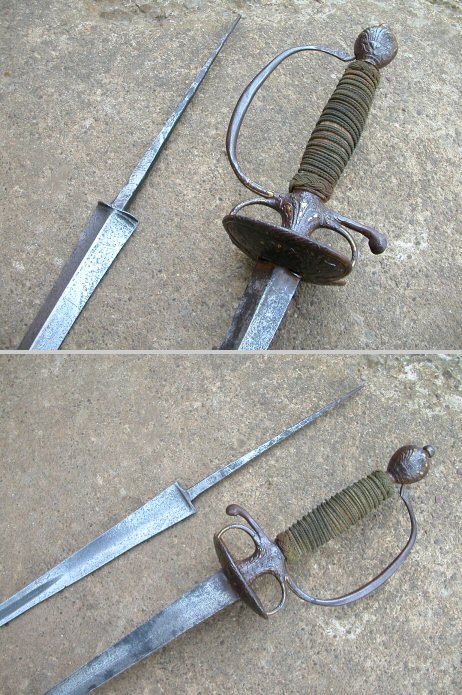
|
|
   |
 |
Stephen A. Fisher

Location: Kentucky USA Joined: 17 Oct 2003
Posts: 455
|
 Posted: Mon 05 Apr, 2004 2:29 pm Post subject: Posted: Mon 05 Apr, 2004 2:29 pm Post subject: |
 |
|
| Steve Fabert wrote: | | Is that a bayonet blade? I don't believe I have ever seen anything except a bayonet that had so pronounced a ridge on one side only. |
Hello Steve,
No, this is a blade for an eighteenth century smallsword. Adult smallsword blades could range from 25-34" (28-32" being the most common) and came in many blade variations: ex. triangular, hexagonal, diamond, flat.
Take a look through the myArmoury.com albums for hundreds of examples.
Smallswords
http://www.myArmoury.com/albums/thumbnails.php?album=55
and my album,
The Smallsword and its variations
http://www.myArmoury.com/albums/thumbnails.php?album=96
-----------------------------------------------------------------------------------------
The socket bayonet, a French invention from the last half of the 17th century also contained a blade of triangular cross section, very similar to that of the smallsword.
 Attachment: 42.61 KB Attachment: 42.61 KB
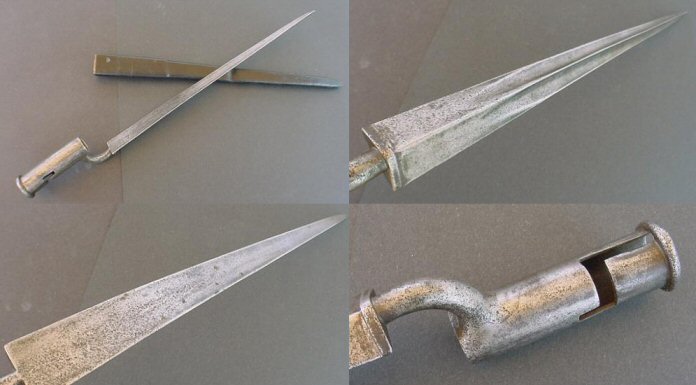
Brown Bess socket bayonet c.1810 (with triangular blade)
|
|
   |
 |
|
Steve Fabert
|
 Posted: Mon 05 Apr, 2004 3:32 pm Post subject: Posted: Mon 05 Apr, 2004 3:32 pm Post subject: |
 |
|
| Stephen A. Fisher wrote: |
No, this is a blade for an eighteenth century smallsword. Adult smallsword blades could range from 25-34" (28-32" being the most common) and came in many blade variations: ex. triangular, hexagonal, diamond, flat.
|
That certainly explains my ignorance. My sword-related reading interests jump from about 1475 to 1815, so I am not familiar with the smallsword variants.
It must have taken a great deal of effort and care for a smith to produce that sort of complex geometry - or were these manufactured with some early form of automation that reduced the degree of individual skill required?
|
|
  |
 |
Sean Flynt

|
|
   |
 |
Stephen A. Fisher

Location: Kentucky USA Joined: 17 Oct 2003
Posts: 455
|
 Posted: Wed 07 Apr, 2004 8:29 pm Post subject: Posted: Wed 07 Apr, 2004 8:29 pm Post subject: |
 |
|
Hi Sean,
Yes, unfortunately the 36" length is a turnoff. Though they could probably be shortened somewhat. I don't know why they have labeled it as a "colichemarde,"  as it is clearly not. I'm not very fond of their rod tangs either. But I'm sure they could probably make something more suitable if asked. as it is clearly not. I'm not very fond of their rod tangs either. But I'm sure they could probably make something more suitable if asked.
______________________________________________________________________________________________
A big thanks to Richard Dellar from the Antique & Military Sword Forum on SFI, he was able to locate the makers mark in the German book, Me Fecit Potzdam: Altpreussisches Blankwaffen des 18 Jahrhunderts ( Prussian Swords of the 18th Century). He mentioned that crossed keys was the trademark of the Solingen cutler Friedrich Herder & Sohn (which still makes knives today). http://www.herder-solingen.de/ He suggested that it could possibly be an early version of the mark.
If one of our German forumites could help out in translating the caption for me, I would be very much obliged. This it what the online translator service deciphered.
"Sign with gekreuzsten keying did not identify in pearl wreath oval on bikonvixer dragoon blade; around 1780"
 Attachment: 72 KB Attachment: 72 KB
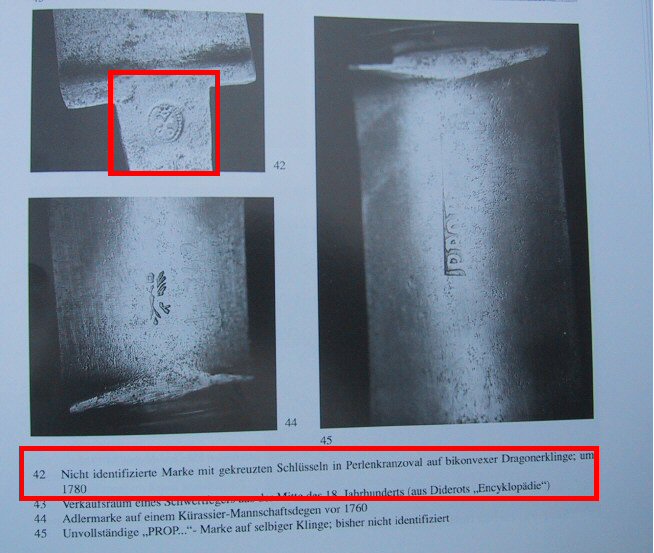
scan from "Me Fecit Potzdam"
 Attachment: 97.92 KB Attachment: 97.92 KB
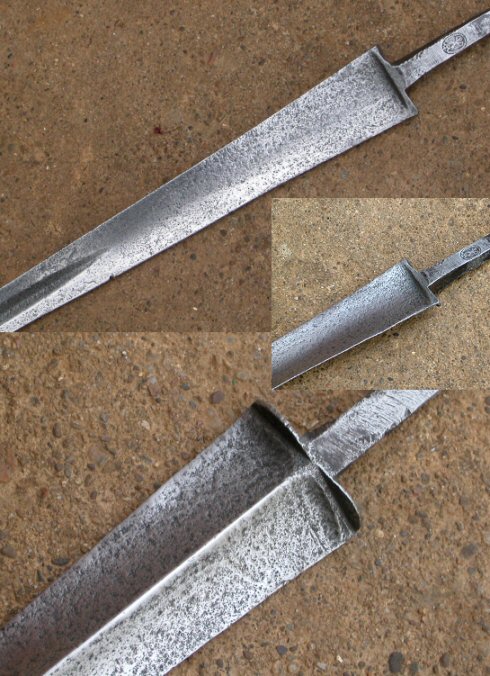
|
|
   |
 |
|
Steve Fabert
|
 Posted: Wed 07 Apr, 2004 9:30 pm Post subject: Posted: Wed 07 Apr, 2004 9:30 pm Post subject: |
 |
|
| Stephen A. Fisher wrote: |
If one of our German forumites could help out in translating the caption for me, I would be very much obliged. This it what the online translator service deciphered.
"Sign with gekreuzsten keying did not identify in pearl wreath oval on bikonvixer dragoon blade; around 1780" |
I am not a native speaker, but it approximates as “Unidentified mark with crossed keys in oval wreath of pearls on double convex dragoon blade - about 1780.”
A similar crown and single key appear on the arms of the city of Bremen. A swordmaker in Bremen may therefore have used such a modified mark.
|
|
  |
 |
Stephen A. Fisher

Location: Kentucky USA Joined: 17 Oct 2003
Posts: 455
|
 Posted: Wed 07 Apr, 2004 10:41 pm Post subject: Posted: Wed 07 Apr, 2004 10:41 pm Post subject: |
 |
|
| Steve Fabert wrote: | | I am not a native speaker, but it approximates as “Unidentified mark with crossed keys in oval wreath of pearls on double convex dragoon blade - about 1780.” |
Thanks Steve.
| Quote: | | A similar crown and single key appear on the arms of the city of Bremen. A swordmaker in Bremen may therefore have used such a modified mark. |
This is an interesting subject. The symbol of St. Peter is a pair of crossed keys, and the symbol was used widely over Europe throughout the centuries on various seals, heraldry, etc. Many also contained a crown above them. But we can can agree that this blade is of German origin considering the source. The only makers mark that I have found thus far is that of Friedrich Herder & Sohn which features crossed keys. (early 20th century example attached)
 Attachment: 11.97 KB Attachment: 11.97 KB
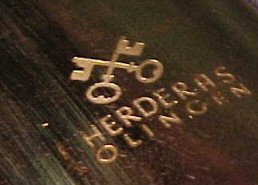
|
|
   |
 |
|
Steve Fabert
|
 Posted: Thu 08 Apr, 2004 4:25 am Post subject: Posted: Thu 08 Apr, 2004 4:25 am Post subject: |
 |
|
|
The presence of the crown in your first photo is what reminded me of the Bremen arms, and I note that the crown is absent from the more recent Herder mark. The crown was generally used to signify the status of a major city like Bremen. But without some confirmation that there were swordmakers in Bremen in the 1780s, it's just a guess. Since the authors of the book containing the photo of a similar mark were unable to identify it, the rest of us are unlikely to figure it out just by pooling our general knowledge of heraldry.
|
|
  |
 |
Stephen A. Fisher

Location: Kentucky USA Joined: 17 Oct 2003
Posts: 455
|
 Posted: Thu 08 Apr, 2004 8:59 am Post subject: Posted: Thu 08 Apr, 2004 8:59 am Post subject: |
 |
|
| Steve Fabert wrote: | | Since the authors of the book containing the photo of a similar mark were unable to identify it, the rest of us are unlikely to figure it out just by pooling our general knowledge of heraldry. |
I agree.
|
|
   |
 |
|
|

